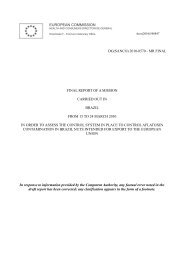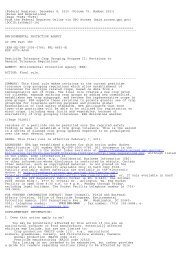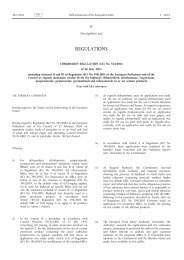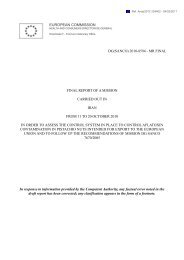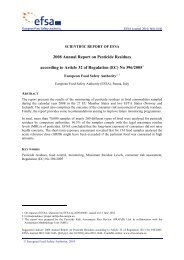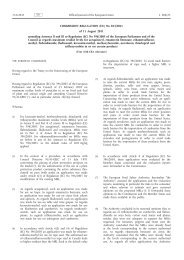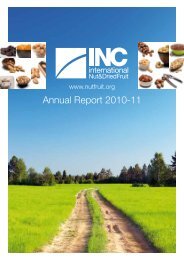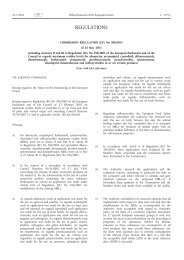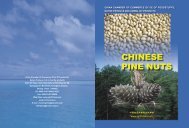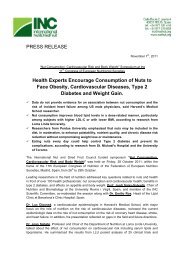2011 Codex Committee on Contaminants in Foods - Institute of Food ...
2011 Codex Committee on Contaminants in Foods - Institute of Food ...
2011 Codex Committee on Contaminants in Foods - Institute of Food ...
- No tags were found...
You also want an ePaper? Increase the reach of your titles
YUMPU automatically turns print PDFs into web optimized ePapers that Google loves.
REP11/CF Appendix II 43APPENDIX IIPROPOSED DRAFT CODE OF PRACTICE FOR THE PREVENTION AND REDUCTION OFETHYL CARBAMATE CONTAMINATION IN STONE FRUIT DISTILLATES(FOR ADOPTION AT STEP 5/8)INTRODUCTION1. Ethyl carbamate is a compound that occurs naturally <strong>in</strong> fermented foods and alcoholic beverages suchas bread, yoghurt, soy sauce, w<strong>in</strong>e, beer, and particularly <strong>in</strong> st<strong>on</strong>e fruit distillates, ma<strong>in</strong>ly those made fromcherries, plums, mirabelles and apricots.2. Ethyl carbamate can be formed from various substances <strong>in</strong>herent <strong>in</strong> food and beverages, <strong>in</strong>clud<strong>in</strong>ghydrogen cyanide (or hydrocyanic acid), urea, citrull<strong>in</strong>e, and other N-carbamyl compounds. Cyanate isprobably the ultimate precursor <strong>in</strong> most cases, react<strong>in</strong>g with ethanol to form ethyl carbamate. Therefore ethylcarbamate reducti<strong>on</strong> measures should focus <strong>on</strong> hydrocyanic acid and other precursors <strong>of</strong> ethyl carbamate.3. Ethyl carbamate is genotoxic and a multisite carc<strong>in</strong>ogen <strong>in</strong> animals and is probably carc<strong>in</strong>ogenic tohumans.4. St<strong>on</strong>e fruit distillates, <strong>in</strong> particular, c<strong>on</strong>ta<strong>in</strong> ethyl carbamate <strong>in</strong> manyfold higher c<strong>on</strong>centrati<strong>on</strong>s thanother fermented foods and beverages. In st<strong>on</strong>e fruit distillates ethyl carbamate can be formed fromcyanogenic glycosides that are natural c<strong>on</strong>stituents <strong>of</strong> the st<strong>on</strong>es. When mash<strong>in</strong>g the fruit, the st<strong>on</strong>es may bedamaged and cyanogenic glycosides from the st<strong>on</strong>es may come <strong>in</strong>to c<strong>on</strong>tact with enzymes <strong>in</strong> the fruit mash.Cyanogenic glycosides are then degraded to hydrocyanic acid/cyanides. Hydrocyanic acid may also bereleased from <strong>in</strong>tact st<strong>on</strong>es dur<strong>in</strong>g a prol<strong>on</strong>ged storage <strong>of</strong> the fermented mash. Dur<strong>in</strong>g the distillati<strong>on</strong> processhydrocyanic acid may be enriched <strong>in</strong> all fracti<strong>on</strong>s. Cyanide <strong>in</strong> the distillates may be oxidized to cyanate,which can react with ethanol to form ethyl carbamate. Certa<strong>in</strong> envir<strong>on</strong>mental c<strong>on</strong>diti<strong>on</strong>s such as exposure tolight, high temperatures and the presence <strong>of</strong> copper i<strong>on</strong>s promote the formati<strong>on</strong> <strong>of</strong> ethyl carbamate <strong>in</strong> thedistillate.5. Although no str<strong>on</strong>g correlati<strong>on</strong> between the level <strong>of</strong> hydrocyanic acid and ethyl carbamate has beenestablished so far, it is evident that under certa<strong>in</strong> c<strong>on</strong>diti<strong>on</strong>s high c<strong>on</strong>centrati<strong>on</strong>s <strong>of</strong> hydrocyanic acid lead tohigher levels <strong>of</strong> ethyl carbamate. A potential <strong>in</strong>crease <strong>in</strong> ethyl carbamate formati<strong>on</strong> has been associated withlevels at or above 1 mg/l hydrocyanic acid <strong>in</strong> the f<strong>in</strong>al distillate. Based <strong>on</strong> practical experiences it can beassumed that from 1 mg <strong>of</strong> hydrocyanic acid up to 0.4 mg ethyl carbamate potentially can be formed <strong>in</strong> an<strong>on</strong>-equimolar relati<strong>on</strong>ship.SCOPE AND DEFINITIONS6. This Code <strong>of</strong> Practice <strong>in</strong>tends to provide nati<strong>on</strong>al and local authorities, manufacturers and otherrelevant bodies with guidance to prevent and/or reduce formati<strong>on</strong> <strong>of</strong> ethyl carbamate <strong>in</strong> st<strong>on</strong>e fruit distillates.Ethyl carbamate formati<strong>on</strong> <strong>in</strong> other alcoholic beverages and foods is not covered <strong>in</strong> this Code.7. The def<strong>in</strong>iti<strong>on</strong>s below apply to this Code:(a) St<strong>on</strong>e Fruit means for the purpose <strong>of</strong> this Code <strong>of</strong> Practice certa<strong>in</strong> edible fruit <strong>of</strong> treesbel<strong>on</strong>g<strong>in</strong>g to the genus Prunus <strong>of</strong> the rose family (Rosaceae), i.e. cherry, plum, peach andapricot.(b) Distillates means, for the purpose <strong>of</strong> this Code <strong>of</strong> Practice, alcohol-rich products obta<strong>in</strong>ed afterthe distillati<strong>on</strong> process and ready for c<strong>on</strong>sumpti<strong>on</strong>.(c) St<strong>on</strong>e Fruit distillates means, for the purpose <strong>of</strong> this Code <strong>of</strong> Practice, the distillates forc<strong>on</strong>sumpti<strong>on</strong>, obta<strong>in</strong>ed after the distillati<strong>on</strong>:- <strong>of</strong> the mash prepared by fermentati<strong>on</strong> <strong>of</strong> crushed st<strong>on</strong>e fruits- <strong>of</strong> fermented st<strong>on</strong>e fruit marc (pomace).- <strong>of</strong> mash obta<strong>in</strong>ed by fermentati<strong>on</strong> and/or macerati<strong>on</strong> <strong>of</strong> crushed and/or whole st<strong>on</strong>efruit <strong>in</strong> ethyl alcohol or alcoholic beverages.



